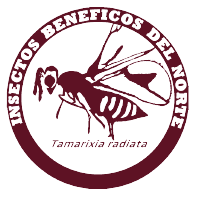WHAT IS IT?
Ectoparasitoid, originating from the Asian continent, currently distributed throughout the world. It has the hability to get used to different conditions; for this reason, it has been widely used in Biological control programs against Diaphorina citri. It lays its eggs in the ventral part of D. citri, nymphs, between the thorax and the abdomen. Immediately after emergence, the larvae of the parasitoid feed by sucking up fluids in the part where it is attached to the host, until the host is mummified. The body is 0.5 to 1 millimeter long; it is dark brown, except for the reddish eyes, while the antennae, legs and marks on the basal and middle tergites of the faster are yellow.
REPRODUCTION
The parasitoid pupa remains external to the ventral surface of its host and the adult generally emerges below the mummified nymph’s cephalic zone through a hole made with its jaws in the dorsal part of the thorax. The most important taxonomic characteristics used in the identification of T. radiata adults are: presence of two distinguishable and almost equal size adnotaular setae in the middle lobe of the mesoscutum, one located in the anterior half of the mesoscutum and the other in the posterior half.


